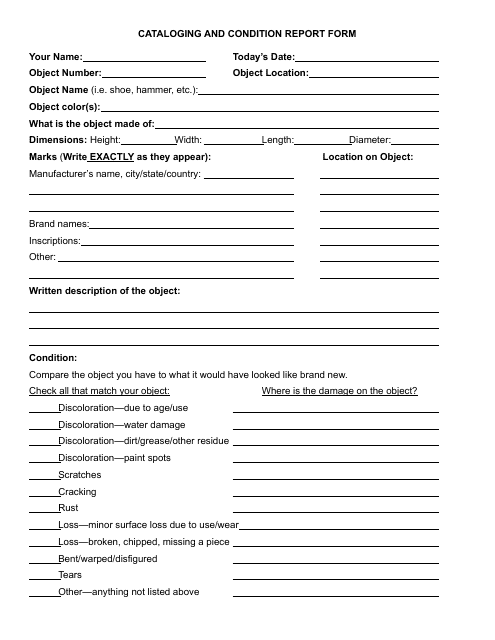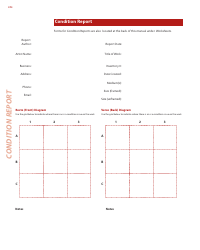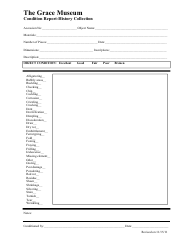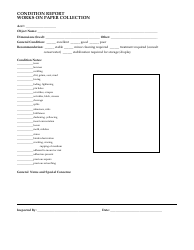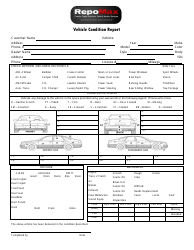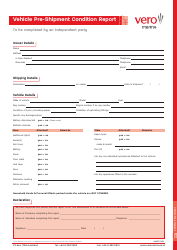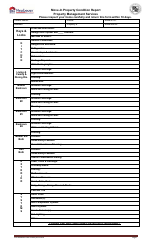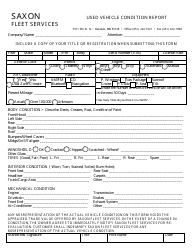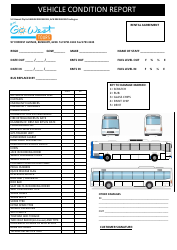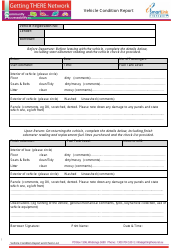Cataloging and Condition Report Form
The Cataloging and Condition Report Form is typically used in various industries such as museums, art galleries, and libraries to systematically record essential information about items in their collections. Its primary purpose is to create a comprehensive record that describes the item and assesses its condition. This form helps in organizing and categorizing the items, making them easier to locate and manage. It also serves as a reference for researchers, conservators, and curators who need to access specific information about the item's provenance, physical characteristics, and any existing damage or deterioration.
The Cataloging and Condition Report Form is usually filed by the organization or institution responsible for managing and preserving the document or artifact. This could be a library, museum, archive, or any other entity that maintains a collection. The purpose of this form is to document the physical condition, details, and other relevant information about the item for cataloging and future reference.
FAQ
Q: What is a Cataloging and Condition Report Form?
A: A Cataloging and Condition Report Form is a document used to record detailed information about an item, such as its physical condition, provenance, and descriptive details, for the purpose of inventorying, documenting, and assessing its value.
Q: Why is a Cataloging and Condition Report Form important?
A: A Cataloging and Condition Report Form is important because it helps to preserve and document the condition and history of an item. It serves as a reference for future identification, valuation, and conservation efforts.
Q: Who uses a Cataloging and Condition Report Form?
A: A Cataloging and Condition Report Form is used by various individuals and organizations involved in the management and care of objects, including museums, galleries, collectors, appraisers, and insurance companies.
Q: What information is typically included in a Cataloging and Condition Report Form?
A: A Cataloging and Condition Report Form typically includes information such as the item's description, measurements, materials, condition assessment, previous ownership, provenance, and any notable markings or damage.
Q: How is a Cataloging and Condition Report Form filled out?
A: A Cataloging and Condition Report Form is typically filled out by examining the item in detail and recording the relevant information in the provided fields or sections. It may involve taking measurements, inspecting for any damages, and documenting any unique features or characteristics.
Q: Are there any standardized Cataloging and Condition Report Forms?
A: Yes, there are standardized Cataloging and Condition Report Forms available, such as those developed by professional organizations like the American Institute for Conservation or specific software used by museums and galleries. However, organizations may also create their own customized forms based on their specific needs and requirements.
Q: How are Cataloging and Condition Reports used in the art world?
A: Cataloging and Condition Reports are commonly used in the art world to document and track the condition, provenance, and value of artworks. They help in establishing authenticity, providing important information for insurance purposes, and assisting with art conservation and restoration efforts.
Q: Can individuals use Cataloging and Condition Report Forms for personal items?
A: Yes, individuals can use Cataloging and Condition Report Forms for personal items as well. This can be particularly useful for valuable or sentimental items, providing a comprehensive record of their condition, provenance, and other relevant details for personal reference or potential future transactions.
Q: Is it necessary to hire a professional to fill out a Cataloging and Condition Report Form?
A: While hiring a professional such as an appraiser, conservation specialist, or curator may be beneficial for certain items, it is not always necessary. Individuals can fill out Cataloging and Condition Report Forms themselves by following guidelines and best practices provided by reputable sources or organizations.
